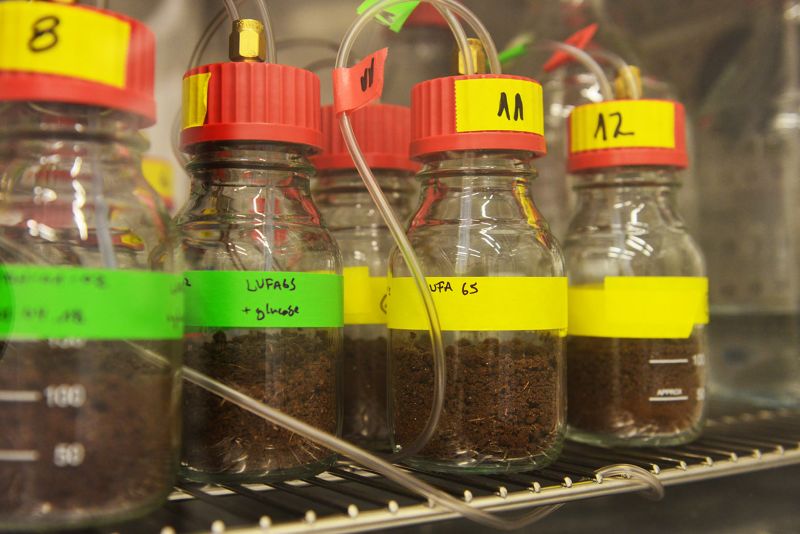Soil Bugs Munch on Plastics (With VIDEO)
Published on by Water Network Research, Official research team of The Water Network in Science
Thin mulch films made of polyethylene are used in agriculture in numerous countries, where they cause extensive soil contamination. Researchers at ETH Zurich and Eawag have now identified an alternative: films made of the polymer PBAT biodegrade in soils.
By: Peter Rüegg
Our world is drowning in a flood of plastic. Eight million tons of plastic end up in the oceans every year. Agricultural soils are also threatened by plastic pollution. Farmers around the world apply enormous amounts of polyethylene (PE) mulch films onto soils to combat weeds, increase soil temperature and keep the soil moist, thereby increasing overall crop yields.
After harvest, it often is impossible for farmers to re-collect the entire films, particularly when films are only a few micrometers thin. Film debris then makes its way into the soil and accumulates in the soil over time, because PE does not biodegrade. Film residues in soils decrease soil fertility, interfere with water transport and diminish crop growth.
Soil microbes mineralise films composed of alternative polymer
Researchers at ETH Zurich and the Swiss Federal Institute of Aquatic Science and Technology (Eawag) have now shown in an interdisciplinary study that there is reason to be hopeful. In their recent study, they demonstrate that soil microbes degrade films composed of the alternative polymer poly(butylene adipate-co-terephthalate) (PBAT). Their work has just been published in the journal Science Advances.
In the research project coordinated by Michael Sander, Kristopher McNeill and Hans-Peter Kohler, former ETH doctoral student Michael Zumstein succeeded in demonstrating that soil microorganisms metabolically utilised the carbon in the PBAT polymer both for energy production and also to build up microbial biomass.

The soils containing the pieces of mulch films are incubated in a temperature-controlled chamber. Microbes that biodegrade the films emit CO2, which is continuously analysed . Source: ETH
“This research directly demonstrates, for the first time, that soil microorganisms mineralise PBAT films in soils and transfer carbon from the polymer into their biomass,” says Michael Sander, Senior Scientist in the Environmental Chemistry Group in the Department of Environmental Systems Science at ETH Zurich.
Like PE, PBAT is a petroleum-based polymer that is used to make various products, including mulch films. Because PBAT was already classified as biodegradable in compost, the ETH and Eawag researchers aimed at assessing whether PBAT also biodegrades in agricultural soils. By comparison, PE does not biodegrade in compost or in soil.
Labelling of polymer with carbon-13
In their experiments, the researchers used PBAT material that was custom-synthesised from monomers to contain a defined amount of the stable carbon-13 isotope. This isotope label enabled the scientists to track the polymer-derived carbon along different biodegradation pathways in soil.
Upon biodegrading PBAT, the soil microorganisms liberated carbon-13 from the polymer.
Using isotope-sensitive analytical equipment, the researchers found that the carbon-13 from PBAT was not only converted into carbon dioxide (CO2) as a result of microbial respiration but also incorporated into the biomass of microorganisms colonizing the polymer surface.
True biodegradation
“The beauty of our study is that we used stable isotopes to precisely track PBAT-derived carbon along different biodegradation pathways of the polymer in the soil,” says Michael Zumstein.
The researchers are the first to successfully demonstrate – with high scientific rigor – that a plastic material is effectively biodegraded in soils.
Because not all materials that were labelled “biodegradable” in the past really fulfilled the necessary criteria. “By definition biodegradation demands that microbes metabolically use all carbon in the polymer chains for energy production and biomass formation – as we now demonstrated for PBAT,” says Hans-Peter Kohler, environmental microbiologist at Eawag.
The definition highlights that biodegradable plastics fundamentally differ from those that merely disintegrate into tiny plastic particles, for instance after exposure of the plastic to sunlight, but that do not mineralise. “Many plastic materials simply crumble into tiny fragments that persist in the environment as microplastics – even if this plastic is invisible to the naked eye,” Kohler says.
Reference
Zumstein MT, Schintlmeister A, Nelson TF, Baumgartner R, Woebken D, Wagner M, Kohler H-P E, McNeill K, Sander M. Biodegradation of synthetic polymers in soils: Tracking carbon into CO2 and microbial biomass. Science Advances, 25 July 2018, doi: sciadv.aas9024
Read full article: ETH Zurich
Attached link
http://www.youtube.com/embed/_ii1uyRHXOEMedia
Taxonomy
- Soil
- Biotechnology
- plastic pollution
- plastic debris
- microplastics
- nanoplastics
- Plastic Ban